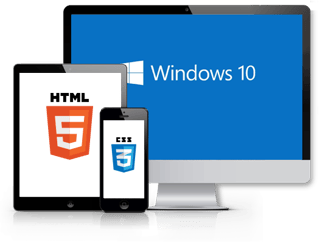Transformation Services
Not Sure Where to Start?
Transformation Services
Not Sure Where to Start?
Transformation Services
Not Sure Where to Start?
For many years developers who wanted a rich user experience relied on Windows or the Macintosh OS to provide those capabilities.
Then the Web happened.
HTML, the language that web browsers relied on, didn't support much of anything besides text and static images. Adobe filled the gap with its Flash authoring tools and runtime--it filled the gap so well that for a time Flash was the most ubiquitious add-in on desktop and laptop computers.
But Flash had its own set of problems, enough that Steve Jobs, CEO of Apple, famously ranted against it in April 2010. Flash was unreliable, Jobs said, and created an unwelcome dependency on third party tools that Apple could not accept (and so there was no Flash support on iPhones or iPads). Jobs wasn't alone: Web developers wanted an HTML standard that had native support for rich applications. Suddenly all kinds of devices were connected to the Internet, including smartphones, tablets, e-book readers, televisions, and more. Developers could no longer count on a given operating system on any platform their application might need to run on; the one thing they could count on was a browser would probably render it.
HTML5, that long-awaited standard, was the answer, and eventually even Adobe acknowledged it, saying that HTML5 was the future and they would stop developing Flash for mobile devices. But HTML isn't finished, although on Dec. 17, 2012, the Worldwide Web Consortium announced a key milestone: the HTML5 specification is complete, so developers can now know what they are working towards.
And even though HTML5 is a work in progress, all major browsers support it (Edge, Chrome, Firefox, Safari, and others), Google built an HTML5 version of YouTube, and developers such as Rovio and Pandora rebuilt their applications to use HTML5.
HTML5 suffered a bit of a PR black eye when Mark Zuckerberg, founder of Facebook, said their attempt to create mobile versions of Facebook using HTML5 was a mistake. But was it? In hindsight, a commercial application like Facebook probably deserves its own native version on every platform it will target. But even if HTML5 was the platform of choice, it's not clear that Facebook's failure was the platform's fault. Sencha looked carefully at how to implement Facebook using HTML5, even going so far as to create their own version. You can read about it here.
HTML5 may be fine for Angry Birds and music players, but what about more mundane (and potentially valuable) line of business (LOB) applications, many of which are written in client-server architectures in languages such as Visual Basic, PowerBuilder, or Informix?
Let's look at Visual Basic (VB). The last version of Visual Basic was 6.0, released in 1998. In 2008 Microsoft formally announced the end of support for VB, and that runtime support will end in 2017). Approximately 24 billion lines of VB code have been written, making it by that metric the most popular application development platform for Windows. But running critical business apps written in VB6 more than 20 years after it was released creates problems and exposes organizations to security vulnerabilities, increased maintenance/support costs, and regulatory non-compliance. A more recent set of problems stems from the "bring your own device (BYOD)" paradigm, where users increasingly want to access LOB applications from smart phones, tablets, and any browser anywhere.
Porting legacy applications to HTML5 solves all these problems, but three significant hurdles must be overcome:
 HTML5 and Mobilize.Net
HTML5 and Mobilize.NetMobilize.Net is the only solution available that combines automated source code conversion with automated refactoring.
For a detailed proposal to convert your legacy applications to HTML5 (or .NET), please contact us today.
8834 N Capital of Texas Hwy, Ste 302
Austin, TX 78759
Call us: +1.512.243.5754
info@wearegap.com